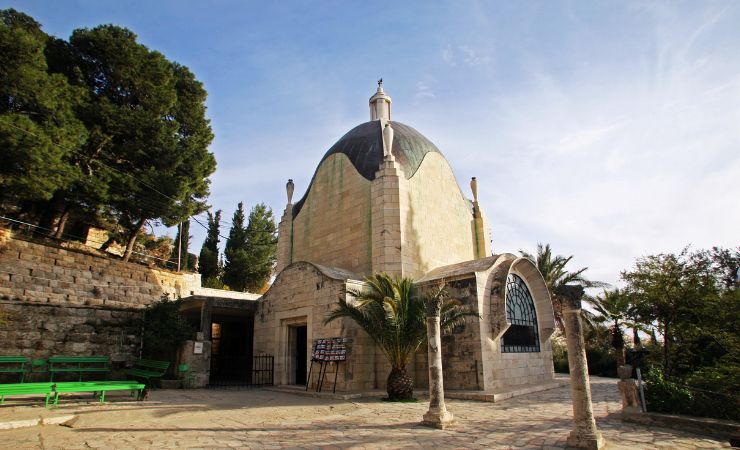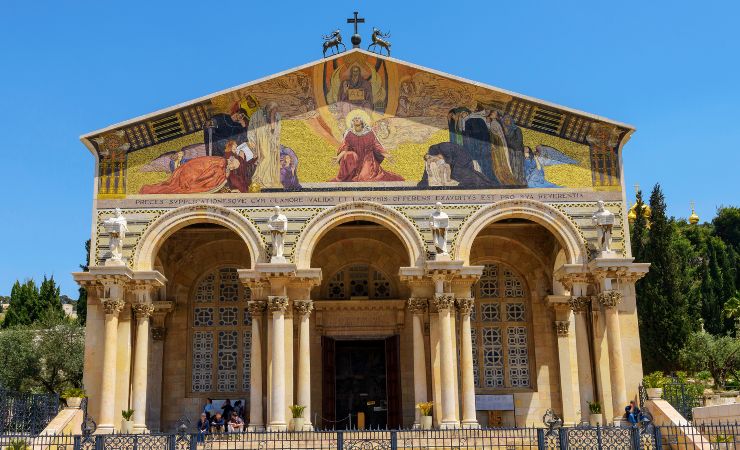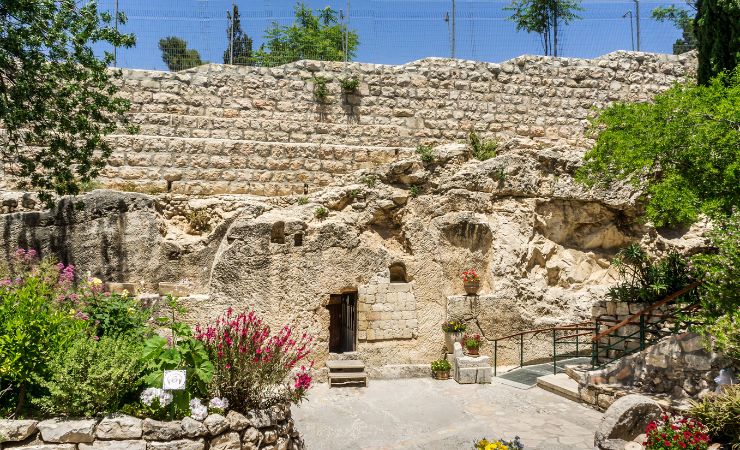Qasr el Yahud: Step into the Sacred Waters of the Jordan River
Qasr el Yahud marks one of the most revered sites in Christian tradition—the very place where Jesus is believed to have been baptized by John the Baptist. This sacred site, whose name translates to “Castle of the Jews,” draws pilgrims and travelers from around the world who come to touch the waters of this ancient river and connect to its profound spiritual history.
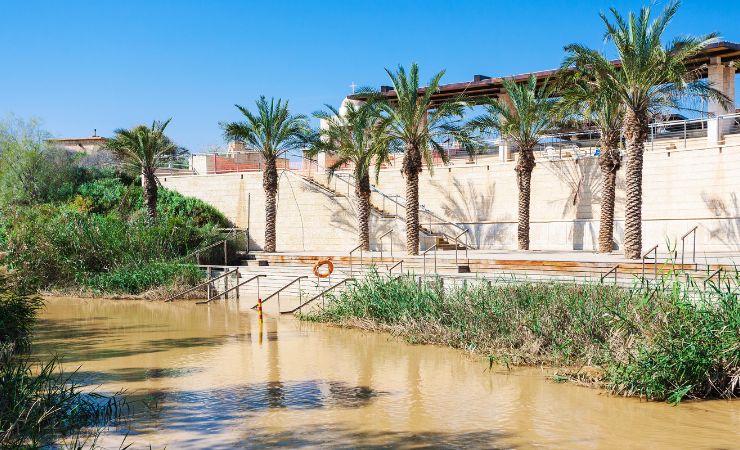
Location
Qasr el Yahud is located in the West Bank, along the banks of the Jordan River, about roughly a 45-minute drive from Jerusalem. The site lies right on the Israel-Jordan border, where the Jordan River forms a narrow boundary between the two countries.
Biblical Context and Old Testament Connection
Qasr el Yahud is profoundly rooted in Old Testament stories making it a landmark for both Jewish and Christian heritage.
Joshua and the Crossing into the Promised Land
After wandering the desert for 40 years, the Israelites, led by Joshua, crossed the Jordan River at this very site to enter the Promised Land. According to the Book of Joshua, as soon as the priests carrying the Ark of the Covenant stepped into the river, the waters miraculously parted, allowing the people of Israel to cross on dry ground (Joshua 3:14–17). This miraculous event marked a pivotal moment in Jewish history, symbolizing the end of their wilderness journey and the beginning of their inheritance.
Elijah and Elisha’s Miraculous Passage
The prophet Elijah, accompanied by his disciple Elisha, also traveled to the Jordan River shortly before he was taken up to heaven. Elijah struck the waters with his cloak, parting the river so they could cross on dry land. Moments later, Elijah was taken up in a fiery chariot, leaving his mantle for Elisha, symbolizing the passing of prophetic leadership (2 Kings 2:7–14).
The Cleansing of Naaman
Naaman, a commander of the Syrian army who suffered from leprosy, was advised by the prophet Elisha to bathe in the Jordan River to be healed. Initially skeptical, Naaman finally obeyed, dipping himself seven times into the river, after which he was miraculously healed (2 Kings 5:1–14). The Jordan’s role as a place of cleansing and healing can still be felt at Qasr el Yahud, where the waters invite pilgrims to renew their faith and seek spiritual healing.
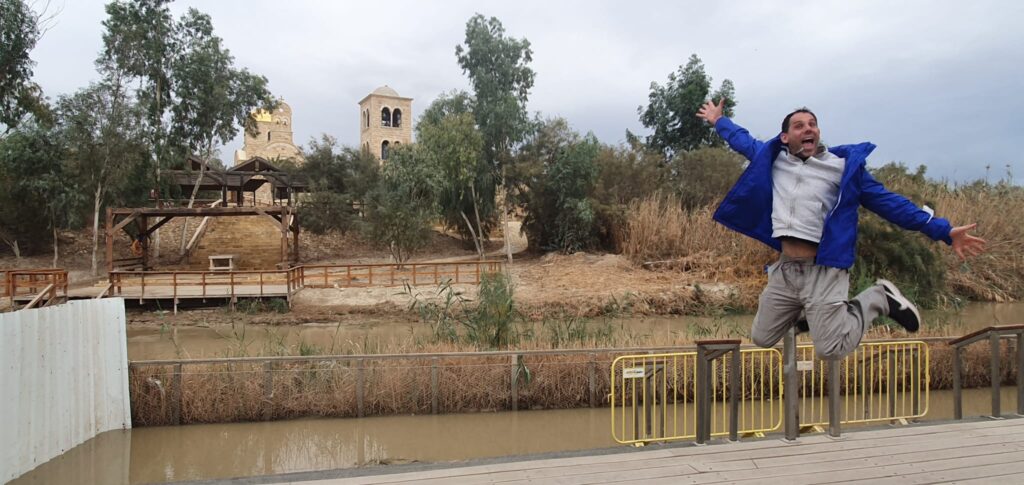
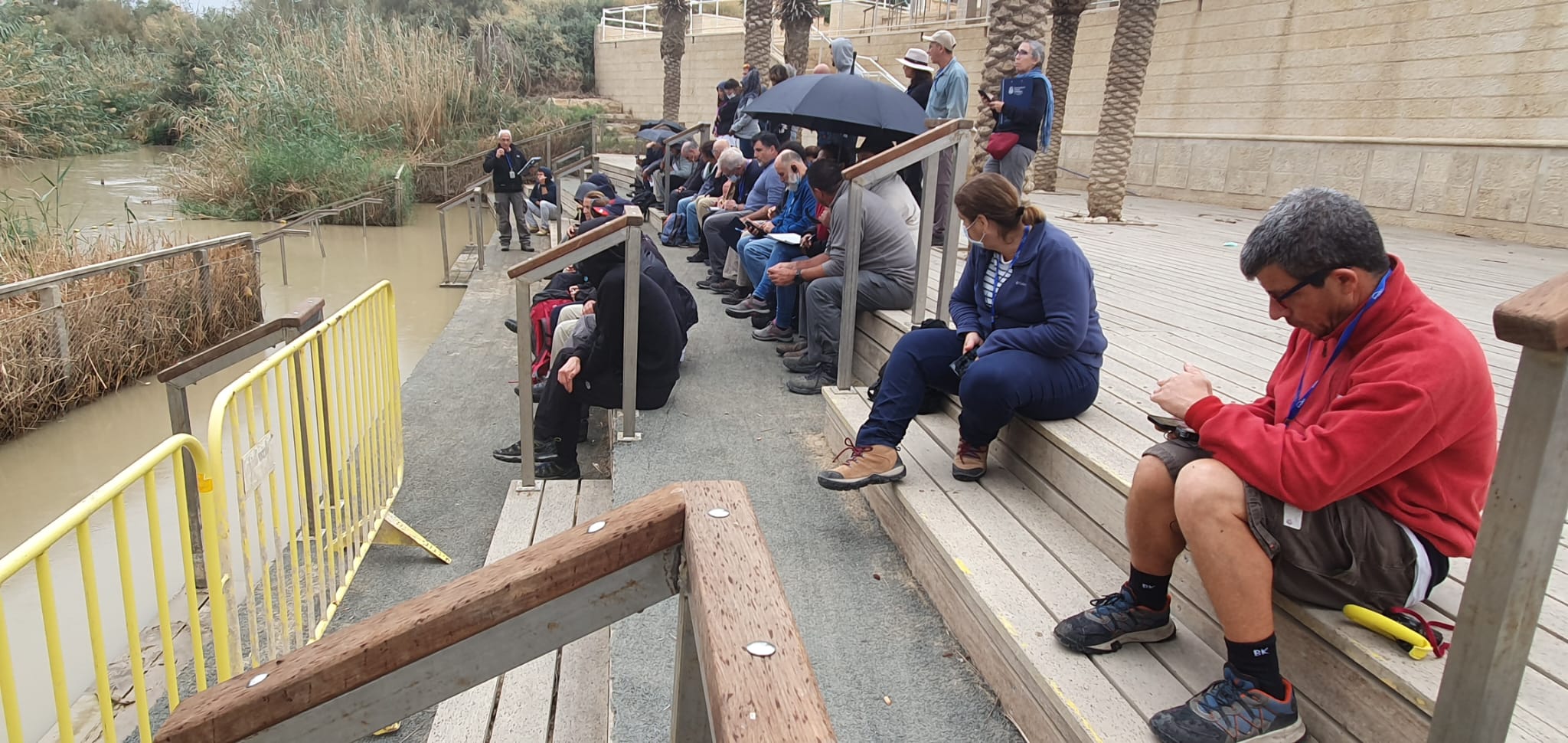
The Baptism of Jesus at Qasr el Yahud
Qasr el Yahud holds a unique place in Christian tradition as the site where Jesus was baptized by John the Baptist. This event is a significant milestone in Jesus’ life, marking the beginning of his public ministry. The baptism is documented across all four Gospels—Matthew, Mark, Luke, and John—underlining its importance in the New Testament.
Biblical Account of the Baptism
According to the Gospel of Matthew (Matthew 3:13–17), Jesus came from Galilee to the Jordan River specifically to be baptized by John. Initially, John was reluctant, telling Jesus, “I need to be baptized by you, and do you come to me?” But Jesus insisted, saying, “Let it be so now; it is proper for us to do this to fulfill all righteousness.” As soon as Jesus was baptized, he came up from the water, and in that moment, the heavens opened. The Spirit of God descended like a dove and alighted upon him, while a voice from heaven declared, “This is my beloved Son, in whom I am well pleased.”
The Significance of Jesus’ Baptism
For Christians, this moment represents a powerful affirmation of Jesus’ identity as the Son of God, with the Holy Trinity—Father, Son, and Holy Spirit—revealed together.
Why Qasr el Yahud?
The Jordan River was a place of cleansing and renewal, and John the Baptist preached a baptism of repentance to prepare people for the arrival of the Messiah. By choosing to be baptized here, Jesus identified himself with humanity’s journey toward redemption, taking a humble step that foreshadowed his sacrificial mission. The sacred waters at Qasr el Yahud have since become a destination for pilgrims who come seeking personal renewal and connection to the divine story of Jesus’ baptism.
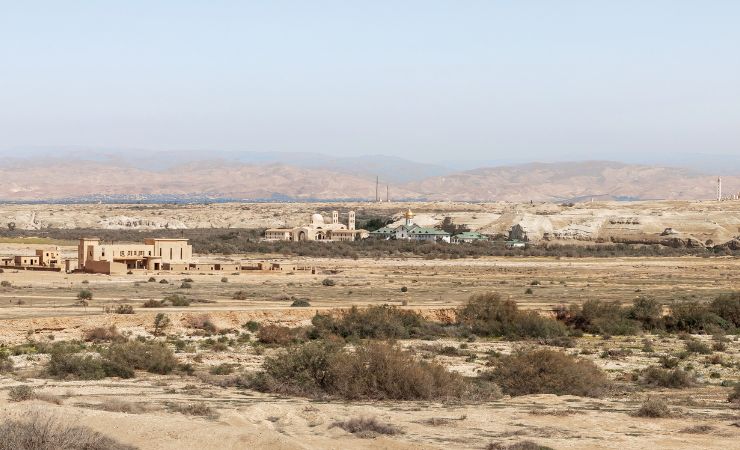



What to See at Qasr el Yahud
Ein Karem has a history that stretches back over 6,000 years, with its earliest settlements dating back to the Neolithic period. By the first century, it was inhabited by Jews, but it wasn’t until the 6th century CE that Christian pilgrims began associating Ein Karem with John the Baptist. The earliest testimony of this association comes from Theodosius, who traveled the Holy Land in the 530s and wrote about the location of Saint Elizabeth’s home, the mother of John the Baptist.
The Church of St. John Ba Harim, affiliated with the Franciscan order, has undergone various architectural phases. Most of the current church structure likely dates back to the 11th century, with some parts possibly from the Byzantine period (4th-7th century). The church’s history reveals a blend of Roman, Byzantine, and Early Muslim influences.
In the 17th century, the site of the Crusader church, built above the traditional birth cave of St. John, was purchased by Franciscan custos, Father Thomas of Novara. Despite challenges, including forced abandonments and the site being used as stables, the Franciscans eventually fortified and rebuilt the site in the late 17th century.
By the end of the 19th century, the church had undergone significant restorations. The main restorations were done between 1857 and 1900, with support from the Royal family of Spain. The royal family of Spain continues to support the church to this day.
During the Second World War, a British artillery unit camped near the church inadvertently caused damage, leading to excavations by the Franciscans. These excavations in the 1940s revealed graves, rock-cut chambers, wine presses, and small chapels with mosaic tiling. Notably, a Jewish ritual bath (Miqveh) was discovered, suggesting Jewish priests might have resided here during the First Century, aligning with the biblical account of Zechariah, John’s father, being a priest.
Epiphany Celebrations at Qasr el Yahud
Every January, Qasr el Yahud becomes a focal point of faith and pilgrimage during the Epiphany celebrations, marking the baptism of Jesus by John the Baptist. The site hosts two main events based on the differing liturgical calendars of the Western and Eastern Christian churches. On January 6th, the Western churches observe Epiphany, with ceremonies that include prayer, hymns, and a solemn procession to the Jordan River. Later, on January 19th, the Eastern Orthodox churches celebrate Theophany, a larger event that draws thousands of Orthodox Christians from around the world. During these ceremonies, clergy in traditional attire bless the waters, and many pilgrims symbolically immerse themselves in the river, reliving the baptismal moment. The celebrations are infused with centuries-old rituals, creating a profound spiritual experience for attendees and adding to the site’s enduring importance as a place of Christian unity and devotion.
What to See at Qasr el Yahud
- The Jordan River and the Baptismal Site: This is the central attraction, believed by Christians to be the location where Jesus was baptized by John the Baptist. Pilgrims often wade into its shallow waters for baptismal ceremonies or symbolic acts of renewal. The river also serves as the border between Israel and Jordan, with the Jordanian baptismal site of Bethany Beyond the Jordan (Al-Maghtas) visible across the narrow waterway.
- Ruins of Historic Churches and Chapels: The area contains remnants of several churches and chapels dating back to the Byzantine and Crusader periods, reflecting the site’s long history of pilgrimage.
- St. John the Baptist Greek Orthodox Monastery: Located nearby, this restored monastery features traditional Orthodox artwork, frescoes, and icons dedicated to John the Baptist. It is built on the ruins of earlier Byzantine-era structures and also commemorates the crossing of the Jordan by the Children of Israel.
- Baptismal Area Facilities: The site is equipped with wooden ramps for easier access to the Jordan River, shaded areas for gatherings and prayer, restrooms, and showers.
- Viewing Platforms: Shaded platforms are available for visitors who prefer to observe the river and the baptismal activities without entering the water.
- Historical Markers: Informational plaques provide details about the biblical and historical significance of Qasr el Yahud.
Nearby Sites
- St. George’s Monastery in Wadi Qelt: An ancient cliffside monastery nestled in the rugged Judean Desert, known for its breathtaking architecture and secluded, serene environment.
- The Dead Sea: The Dead Sea offers a one-of-a-kind experience to float in its salty, mineral-rich waters and take in the dramatic desert landscape.
- Qumran: Just a short drive south, Qumran is the site where the Dead Sea Scrolls were discovered. These fascinating texts include some of the oldest known copies of the Hebrew Bible.
- Ein Gedi Synagogue: A 6th-century gem, features a beautifully preserved mosaic floor with Hebrew inscriptions.
Additional Information
Ancient Times:
- c. 1400 BC: According to tradition, Joshua leads the twelve tribes of Israel across the Jordan River at the location later associated with Qasr el Yahud to enter Canaan after 40 years of wandering in the desert. The waters of the Jordan miraculously part.
- Biblical Era (Old Testament):The Jordan River gains significance through the acts of prophets Elijah and Elisha.
- Elijah and Elisha reportedly cross the Jordan River after Elijah strikes the water with his cloak, causing it to part. Elijah is later taken up to heaven in a fiery chariot from this area, leaving his mantle to Elisha.
- The prophet Elisha instructs Naaman, a commander of the Syrian army suffering from leprosy, to bathe seven times in the Jordan River, after which he is miraculously healed.
Early 1st Century AD:
- c. AD 28-29: The ministry of John the Baptist begins in the wilderness near the Jordan River. He preaches a baptism of repentance for the forgiveness of sins.
- c. AD 28-29 (shortly after John’s ministry begins): Jesus travels from Galilee to the Jordan River to be baptized by John the Baptist.
- The baptism likely takes place at Al-Maghtas (Bethany Beyond the Jordan), near present-day Al-Maghtas, Jordan, or the area now known as Qasr el Yahud on the West Bank.
- According to the Synoptic Gospels, John is initially reluctant to baptize Jesus but agrees at Jesus’ insistence to “fulfill all righteousness.”
- Immediately after Jesus’ baptism, the heavens open, and the Spirit of God descends upon him like a dove. A voice from heaven declares, “This is my beloved Son, in whom I am well pleased.” (Matthew) or “You are my beloved Son, in whom I am well pleased.” (Mark, Luke).
- The Gospel of John does not directly narrate the baptism but records John the Baptist bearing witness to the Spirit descending like a dove upon Jesus.
- The baptism of Jesus is generally considered the start of his public ministry.
- Post-Baptism:The Synoptic Gospels describe the temptation of Jesus, where he withdraws to the Judean desert to fast for forty days and nights.
- The Gospel of John recounts Jesus meeting two of John the Baptist’s disciples who then follow Jesus, marking the beginning of the relationship between Jesus and his future disciples.
Byzantine Period (c. 4th – 7th Centuries AD):
- Churches and monasteries begin to be built at the baptismal site on the Jordan River (Qasr el Yahud area) due to its significance.
Crusader Period (c. 11th – 13th Centuries AD):
- The Qasr el Yahud area flourishes again with thousands of Christian pilgrims visiting to be baptized in the Jordan River. Records indicate as many as 60,000 pilgrims in 1172.
Mamluk Period (c. 13th – 16th Centuries AD):
- Due to fragile security conditions, many churches and monasteries in the Qasr el Yahud area are slowly deserted. Pilgrimage becomes difficult, and pilgrims become afraid to stay overnight.
British Mandate Period (1920 – 1948):
- New churches and monasteries are built in the Qasr el Yahud area.
- Thousands of Christian pilgrims visit the site annually until 1967 to be baptized and take water from the Jordan River.
- 1933: Empress Menen Asfaw of Ethiopia presides over the consecration of the Ethiopian Monastery of the Holy Trinity at Qasr al-Yahud. The architects were Clifford Holliday and Andoni Baramki.
- 1930s: A chapel is built by Franciscan friars near the Jordan River at Qasr al-Yahud.
- 1935: The larger Church of St. John the Baptist (Franciscan) is built at Qasr al-Yahud.
- 1930s: Rare videos record baptismal ceremonies taking place at Qasr al-Yahud.
- 1940s: Excavations near the Church of St. John Ba Harim (Ein Karem, associated with John the Baptist’s birth) reveal graves, chapels, and a Jewish ritual bath from the First Century.
- 1955: The Greek Orthodox Monastery of St. John the Baptist at Qasr al-Yahud is restored.
- December 18, 1956: An earthquake strikes the region, destroying the large Franciscan church at Qasr al-Yahud. Restoration work begins afterwards.
Post-1948:
- 1967 (Six-Day War): The area of Qasr al-Yahud becomes a minefield and a fenced military zone after Israel’s occupation of the West Bank. The Church of St. John the Baptist and other monasteries are closed.
Late 20th Century:
- 1980s: Baptismal ceremonies at Qasr al-Yahud are revived by diverse Christian communities.
- 1990s (after the Israel-Jordan peace agreement): Plans are drawn up to redevelop the Qasr al-Yahud area and allow pilgrims more free access.
21st Century:
- March 2000: Pope John Paul II visits Al-Maghtas on the Jordanian side of the Jordan River, recognizing it as a likely location for Jesus’ baptism.
- 2011: After mine clearance efforts, the Qasr al-Yahud baptismal site is officially restored and opened to the public by Israeli authorities.
- The Israeli Ministry of Tourism invests in renovating and upgrading the Qasr al-Yahud site, including constructing wooden ramps, shaded areas, and facilities.
- The HALO Trust, a British mine clearance organization, works to remove approximately 4000 mines from the Qasr al-Yahud area with the consent of Israeli and Palestinian authorities, allowing eight churches (including Catholic, Greek Orthodox, Armenian, Coptic, Ethiopian, Romanian, Syrian, and Russian) to regain possession of their properties.
- November 2020: The Custody of the Holy Land (Franciscan friars) officially takes possession of the Church of St. John the Baptist at Qasr al-Yahud after its closure in 1967. Plans are made for further recovery and enhancement of the property for pilgrims.

